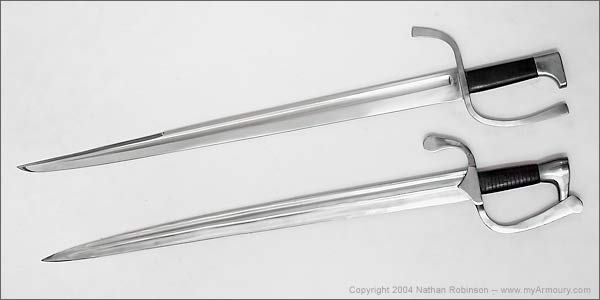| Author |
Message |
|
Danny Grigg
|
 Posted: Fri 22 Aug, 2008 1:36 am Post subject: English short single edged sword? Posted: Fri 22 Aug, 2008 1:36 am Post subject: English short single edged sword? |
 |
|
Can anyone provide me with information about the type of sword shown in the following links:
(Its the single edged sword in the middle)
http://www.fioredeiliberi.org/gallery2/main.p...emId=13125
http://www.fioredeiliberi.org/gallery2/main.p...emId=13128
http://www.fioredeiliberi.org/gallery2/main.p...emId=13104
There's a replica of one at the following link and its called a "Hanger":
Direct Link:
http://www.kp-art.fi/jt/miekat/img/hanger_miekka.jpg
3/4's of the way down, described as "A light medieval hanger-sword."
http://www.kp-art.fi/jt/miekat/miekat2_e.html
I'm wondering if the term Hanger is appropriate for this type of sword? I always thought a Hanger was a Hunting Sword, the equivalent of the German Hirschfänger.
So what label / name is appropriate for this type of sword?
There's a picture of this type of sword in the book "Weapon A Visual History of Arms And Armour" published by Dorling Kindersley.
Here's the description:
Short Sword
Date c.1500
Origin England
Weight 0.79 kg
Length 74.5 cm
Used primarily by foot soldiers, this English-style sword was designed with a single edge and a sharp point. The quillons are extended in length, and the rear quillon bent upwards and backwards towards an extended pommel, thereby forming a simple knucklebow.
I'm interested in any further information about this type of sword? Are there any books that discuss this type of sword?
If anyone has further pictures of this type of sword (originals / replicas etc) please post.
Thanks
Danny
|
|
  |
 |
Nathan Robinson
myArmoury Admin


|
 Posted: Fri 22 Aug, 2008 1:53 am Post subject: Posted: Fri 22 Aug, 2008 1:53 am Post subject: |
 |
|
As written in British Basket-hilted Swords, Cyril Mazansky:
| Quote: | Royal Armouries ix.144 (c.1460)
These swords have no true knuckle-guard or side-guard. A forward quillon is curved in the plane of the blade towards the tip of a snout-like or beak-shaped pommel (type XVII) to act as a knuckle-guard and extends to the pommel level. The rear quillon is short and recurved towards the blade. The only side-guard is a short straight lug projecting at right angles on the quillon-block on the outside of the hilt. On the example shown it has been broken off. The Museum of London hilt (84-203) is the same.
Comment
These examples of the precursors of basket-hilt types lack both a true main knuckle-guard and side-guards. However, the long recurved front quillon in both and the lug or short bar on the outside of the hilt at the blade end in type A2, probably represent these morphologically and certainly functionality. |
This book describes these, briefly, and talks about how they fit into the developmental progression of basket-hilts. At least six examples of this type are shown.
*I* would not call these hangers. I would call them single-edged medieval swords.
Other modern-made samples:

Museum Replicas "Wakefield" Sword -- Click for more info

Created by Michael 'Tinker' Pearce
Side-by-side:

.:. Visit my Collection Gallery :: View my Reading List :: View my Wish List :: See Pages I Like :: Find me on Facebook .:.
|
|
    |
 |
|
Jonathan Hopkins
|
|
  |
 |
Roger Hooper

|
 Posted: Fri 22 Aug, 2008 7:18 am Post subject: Posted: Fri 22 Aug, 2008 7:18 am Post subject: |
 |
|
Del Tin makes a version of this sword. So does J.T. Palikko of Finland. Some people would call it a light falchion.
 Attachment: 75.84 KB Attachment: 75.84 KB

J. T. Palikko
 Attachment: 30.97 KB Attachment: 30.97 KB
DT5159 [ Download ]
|
|
  |
 |
Sean Flynt

|
 Posted: Fri 22 Aug, 2008 7:33 am Post subject: Posted: Fri 22 Aug, 2008 7:33 am Post subject: |
 |
|
In modern usage, "hanger" is appropriate for a short infantry or hunting sword, usually curved and post-1600. I'm not sure why there's a chronological distinction, though. The sword in question would be called a hanger or falchion if it turned up in a 16th or 17th c. context. It doesn't sound too strange to me to hear this sword called a hanger, even given its date. I think I'd call this a falchion because it differs little from later weapons we call falchions (interchangeably with "hanger"). The main point of contention might be the straight blade, which argues more for just plain old "sword".
More to the point, although not all swords are falchions or hangers, all hangers and falchions are swords. When in doubt, just default to "sword" and you won't be wrong.
-Sean
Author of the Little Hammer novel
https://www.amazon.com/Little-Hammer-Sean-Flynt/dp/B08XN7HZ82/ref=sr_1_1?dchild=1&keywords=little+hammer+book&qid=1627482034&sr=8-1
|
|
   |
 |
|
|

